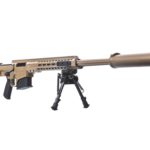The AR-15 series of rifles is one of the most versatile long gun platform ever invented.
Developed in the late 1950s, the AR-15 is available in broad array of calibers, from .50 Beowulf to .22 Long Rifle. One of the most novel adaptations of the platform is to accommodate semi-automatic handgun calibers. The result is a weapon that appears similar to the basic AR-type weapon but which has significant differences “under the hood.”
The original AR-15 weapon was adopted by the U.S. military in the mid-1960s as the M16 assault rifle . The M16 fired 5.56-millimeter ammunition and used the direct impingement gas operating system to cycle the weapon. Under the direct impingement system the M-16 siphoned off hot, high pressure gunpowder gasses from the barrel to cycle itself. The gasses drove the bolt carrier group (BCG) backward out of battery, ejecting the spent brass cartridge. As the BCG continued rearward it made contact with a spring-backed buffer tube which propelled it forward again. Moving forward, the BCG picked up a fresh round and returned to battery, ready to fire.
The direct impingement system was an integral part of the M16 rifle, and was carried over to successive versions including the M16A1, M16A2, M16A3, M16A4, and the M4 carbine. In the 1980s, Colt decided to take a different tack and develop a new version in 9-millimeter Parabellum, a popular pistol cartridge. The use of a pistol cartridge, which used significantly less gunpowder than the 5.56 cartridge and generated significantly less gunpowder gases, necessitated a reworking of the new weapon’s operating system.
by Kyle Mizokami



